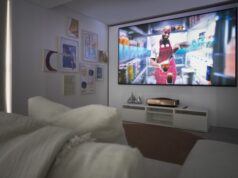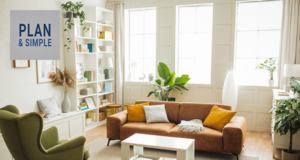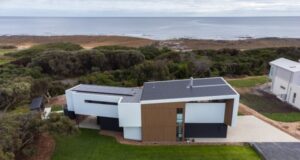
Glass splashbacks are typically installed as a single piece, look fantastic and do away with the need for grouting and related maintenance. They are, however somewhat expensive and require a little care.

Look behind the sink of many contemporary kitchens these days and you’re likely to see yourself reflected in a glass splashback.
Glass splashbacks are functional, and in the certain styles of kitchen can create a very attractive look. With few or no joins, single-surface splashbacks like glass have fewer points at which mould can grow – although if they’re not sealed properly around the edges, this can still be a problem.
How are glass splashbacks made?
Glass splashbacks are usually made from float glass (or low-iron glass, if a clearer, less greenish glass is what’s needed). Splashback glass needs to be toughened to meet the requirements of Australian Standard AS2208 – Safety glazing materials for use in buildings where cutouts and notches are called for – or if the splashback is going to be installed behind a heat source like a cooktop. Toughened glass should carry an AS2208 label, and glass splashbacks need to be a minimum of 6mm toughened glass.
Splashbacks for hot water or appliance areas need to be be accompanied by a letter from an architect, designer, glass supplier or glass manufacturer that states that the splashback is fit for the purpose for which it’s been designed – and the surface of the wall needs to be heatproofed in accordance with the relevant building code requirements.
Colours and styles
Glass splashbacks are available in a variety of different colours and styles. The two main forms of colouring the glass are:
- Ceramic frit, in which ceramic paint is screen-painted onto the glass and then baked on during the toughening process.
- Applied two pack urethane, which is usually spray-painted onto pre-toughened glass and then either air-dried or baked on.
Because toughened glass can’t be drilled or cut after it’s been toughened (although laminated safety glass can be), initial measurements need to be accurate and no changes can be made. Glass splashbacks can be mounted into most kitchen surfaces, but toughened glass in particular will require extra care.
If you’re interested in a coloured glass splashback, make sure you look for warranties against fading, delamination and similar degradation of the colour coating. It’s also a good idea to stick to recognised colour palettes.
Another option beyond basic colouring is to have digital images or patterns printed on.
Glass costs
Glass splashbacks tend to be fairly expensive – at least twice as expensive as tiling – with final costs often hinging on the paint selected, batch size and how much work’s involved in cut-outs and notches, polishing exposed edges and so forth. Costs may range anywhere from $100 to $400 or beyond per square metre.
Installation considerations
Some suppliers will insist on using their own installers to keep the warranty intact; however in most cases a glazier or builder will be able to fit the splashback without too much trouble.
With toughened glass being unalterable, the biggest issue is correct measurement. This should be done close to installation – allow for at least two weeks from the order date for the splashback to be prepared. If the measurements aren’t precise, your splashback won’t be usable. Expensive replacements are all too common!
Splashbacks can be placed onto studs, tiles, plaster or anything else that will hold it, although the material it’s mounted on will be visible unless the glass is completely opaque. Clear silicon should be used around the border of glass splashbacks wherever glass meets another surface, such as a cabinet or bench.
Glass splashbacks are subject to various different stringent standards, so there are all kinds of small limitations that apply to how it’s cut and shaped. A reputable supplier should be able to advise on what’s best for your kitchen.
LED and mirrored glass splashbacks
If you’re looking for something particularly striking, you might even like to consider installing LED lights behind your glass splashback. LEDs can be set either to stay on one colour, or to periodically change colours.
If lighting isn’t your thing, perhaps a mirrored splashback is. These can open up the kitchen, however they also have the potential to amplify clutter if it’s there! Mirrored splashbacks don’t stand up as well to moisture or food debris either – standard glass is generally stronger.
Maintenance
If you are considering glass, it’s also worth remembering that because it’s a single, pristine reflective surface, small marks and smudges are likely to show up fairly prominently from the wrong angles if they’re left that way. Fingerprints, watermarks and food stains in particular may be quite obvious. Having said that, cleaning a glass splashback is as easy as wiping it down with a bit of glass cleaner.
|
Advantages
|
Disadvantages
|





